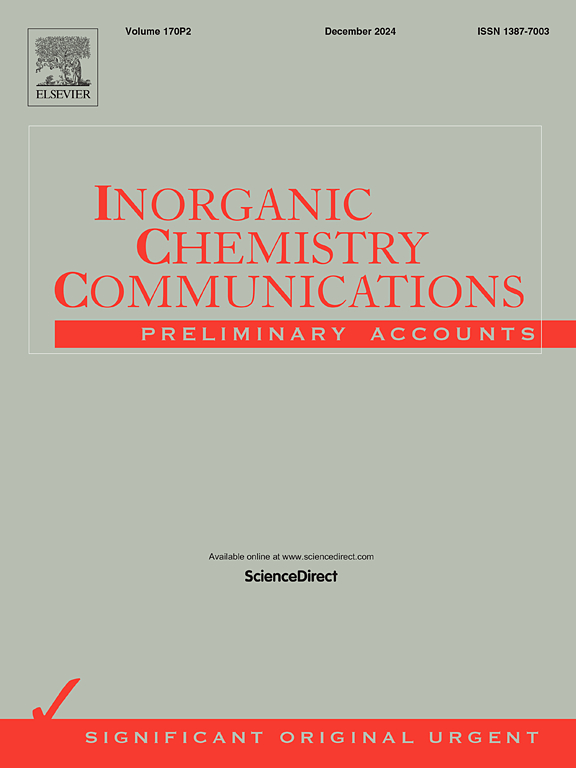Advantageous development of PbS/ZnS nanocomposite photocatalysts from underutilized ionic precursors of solar paints
IF 4.4
3区 化学
Q1 CHEMISTRY, INORGANIC & NUCLEAR
引用次数: 0
Abstract
Under-utilized ionic precursors of successive ionic layer adsorption and reaction (SILAR) processes have been used to develop nanoscale metal chalcogenide particles previously. In this work, we have modified the salvaging approach to produce the nanocomposites (NCs) of PbS and ZnS, strategically named as PbS/ZnS (NC-1) and PbS/ZnS (NC-2), owing to the stoichiometric difference evolved between them during the salvaging methods. The PbS/ZnS NCs offered superior optical, electronic, and electrochemical characteristics than PbS and ZnS individually. PbS/ZnS (NC-1) exhibited enhanced light absorbance as revealed by UV–Vis spectroscopy and thus a better electrochemical current density-relevant behavior (as a function of Potential Vs RHE). As indicated by EIS, PbS/ZnS (NC-2) possessed an appreciable tendency to govern the degradation of toxic Rhodamine B (RhB) dye under solar light having UV and Visible range of radiation concomitantly. The dye degradation results showed a significant increase in the dye degradation rate up to 65% for PbS/ZnS for NC-1 and 85% for PbS/ZnS NC-2. Inventively developed PbS/ZnS NCs from under-utilized (waste) ionic precursors of SILAR were also analyzed in-depth using SEM, EDS, EIS, XRD, etc., to widen the scope of the work which suggests that simple modifications in the salvaging approach can facilitate the development of more versatile NCs of metal chalcogenides simplistically and proficiently from the underutilized ionic precursors used in the development of solar paints via SILAR.

利用太阳能涂料中未充分利用的离子前体开发 PbS/ZnS 纳米复合光催化剂的优势
以前曾利用未充分利用的连续离子层吸附和反应(SILAR)过程的离子前体来开发纳米级的金属铬化物颗粒。在这项工作中,我们对打捞方法进行了改进,制备出了 PbS 和 ZnS 的纳米复合材料(NCs),由于在打捞过程中它们之间发生了化学计量学差异,因此将它们分别命名为 PbS/ZnS (NC-1) 和 PbS/ZnS (NC-2)。与单独的 PbS 和 ZnS 相比,PbS/ZnS NC 具有更优越的光学、电子和电化学特性。紫外可见光谱显示,PbS/ZnS(NC-1)具有更强的光吸收能力,因此具有更好的电化学电流密度相关特性(电位与 RHE 的函数关系)。如 EIS 所示,PbS/ZnS(NC-2)在同时具有紫外线和可见光辐射范围的太阳光下,具有明显的控制有毒罗丹明 B(RhB)染料降解的趋势。染料降解结果表明,PbS/ZnS NC-1 和 PbS/ZnS NC-2 的染料降解率分别显著提高了 65% 和 85%。此外,还利用扫描电镜、EDS、EIS、XRD 等对利用 SILAR 未充分利用(废弃)的离子前驱体创造性地开发出的 PbS/ZnS NCs 进行了深入分析,从而拓宽了工作范围。
本文章由计算机程序翻译,如有差异,请以英文原文为准。
求助全文
约1分钟内获得全文
求助全文
来源期刊

Inorganic Chemistry Communications
化学-无机化学与核化学
CiteScore
5.50
自引率
7.90%
发文量
1013
审稿时长
53 days
期刊介绍:
Launched in January 1998, Inorganic Chemistry Communications is an international journal dedicated to the rapid publication of short communications in the major areas of inorganic, organometallic and supramolecular chemistry. Topics include synthetic and reaction chemistry, kinetics and mechanisms of reactions, bioinorganic chemistry, photochemistry and the use of metal and organometallic compounds in stoichiometric and catalytic synthesis or organic compounds.
 求助内容:
求助内容: 应助结果提醒方式:
应助结果提醒方式:


